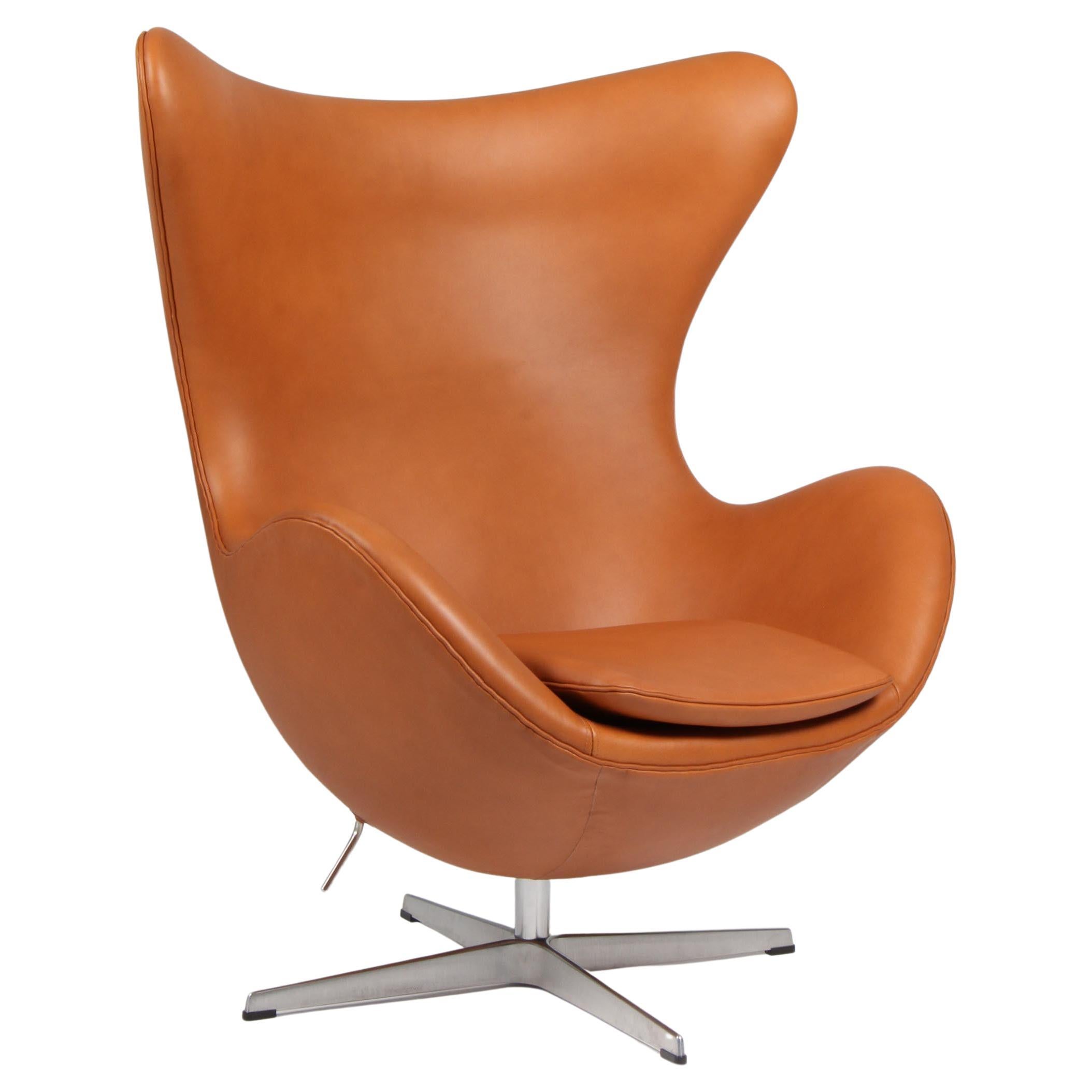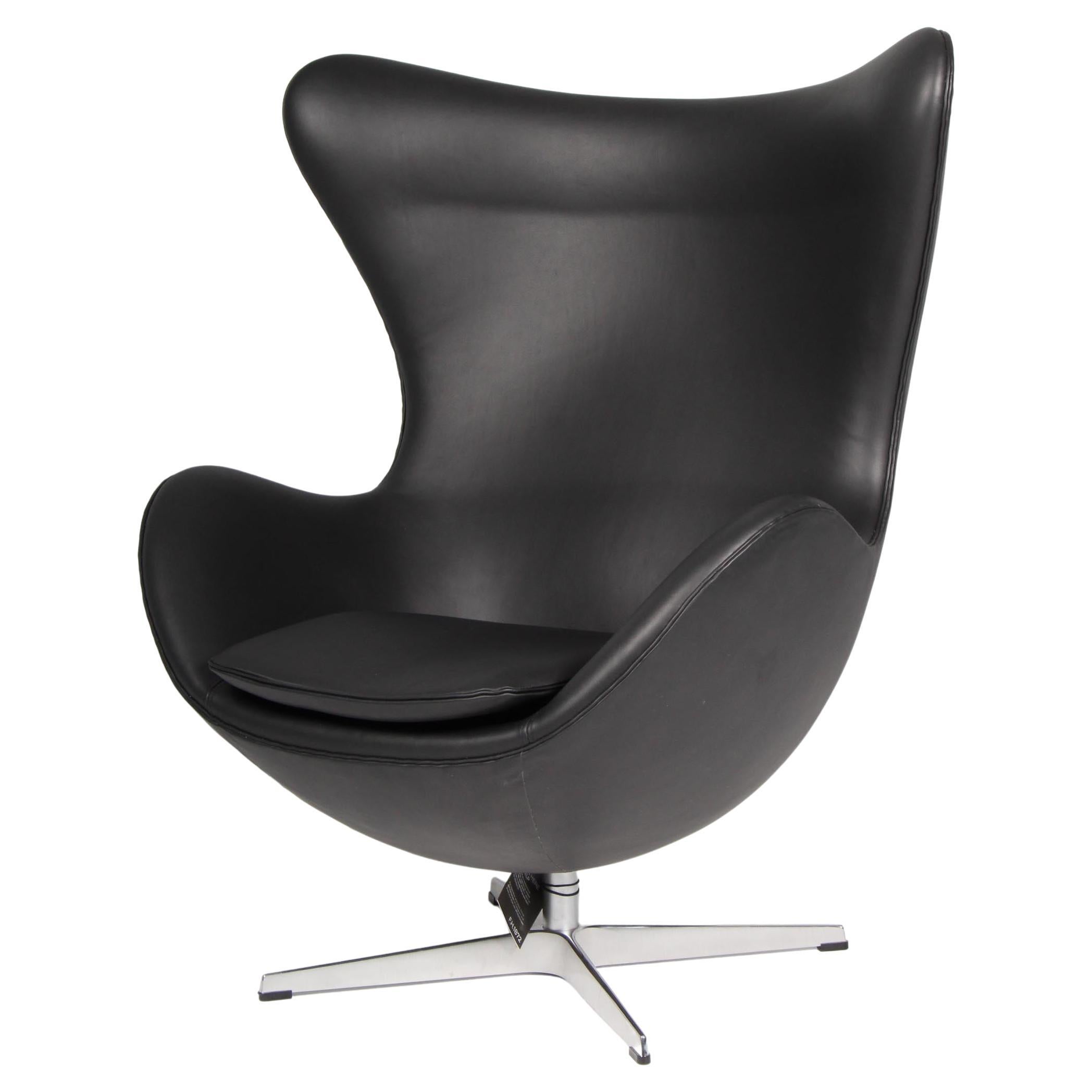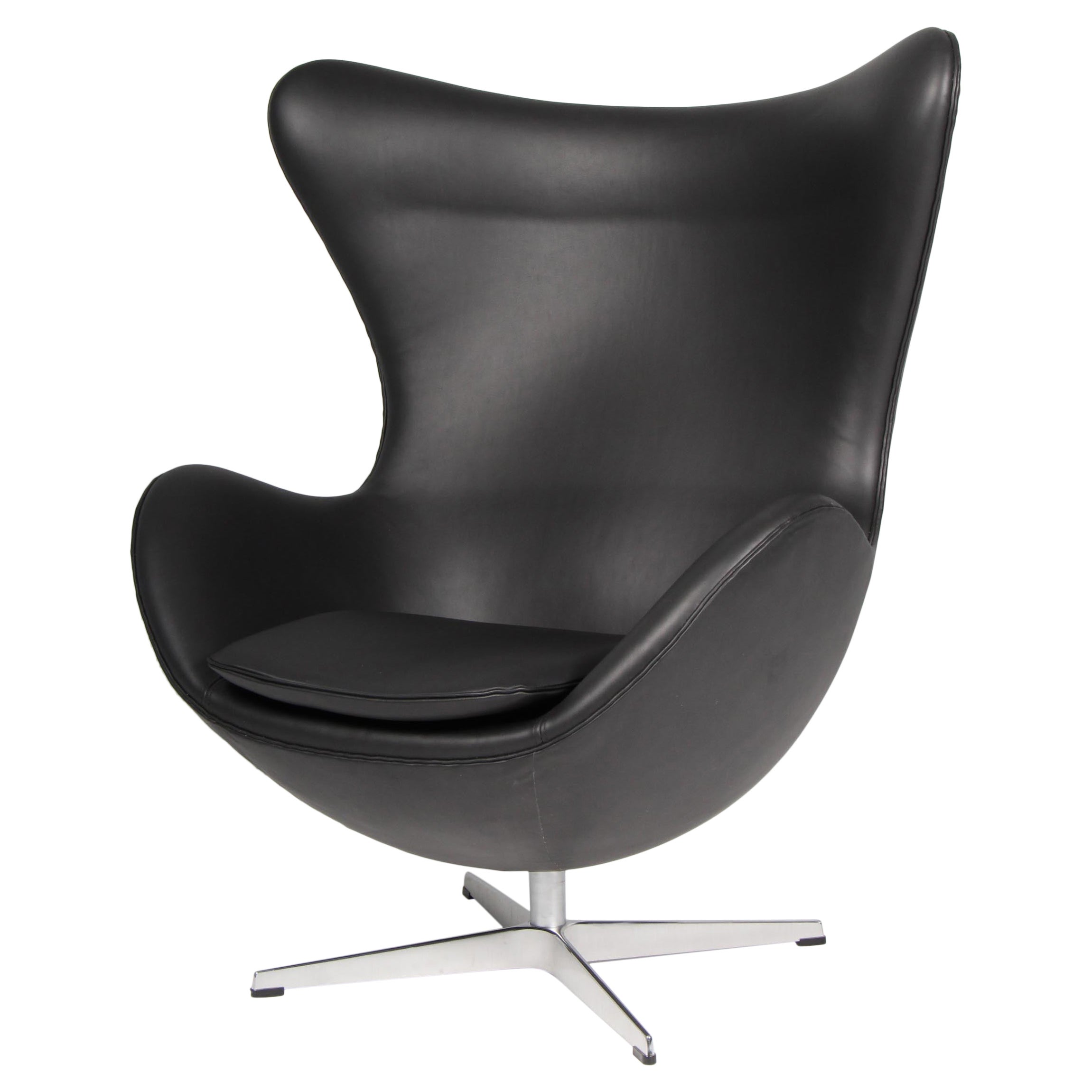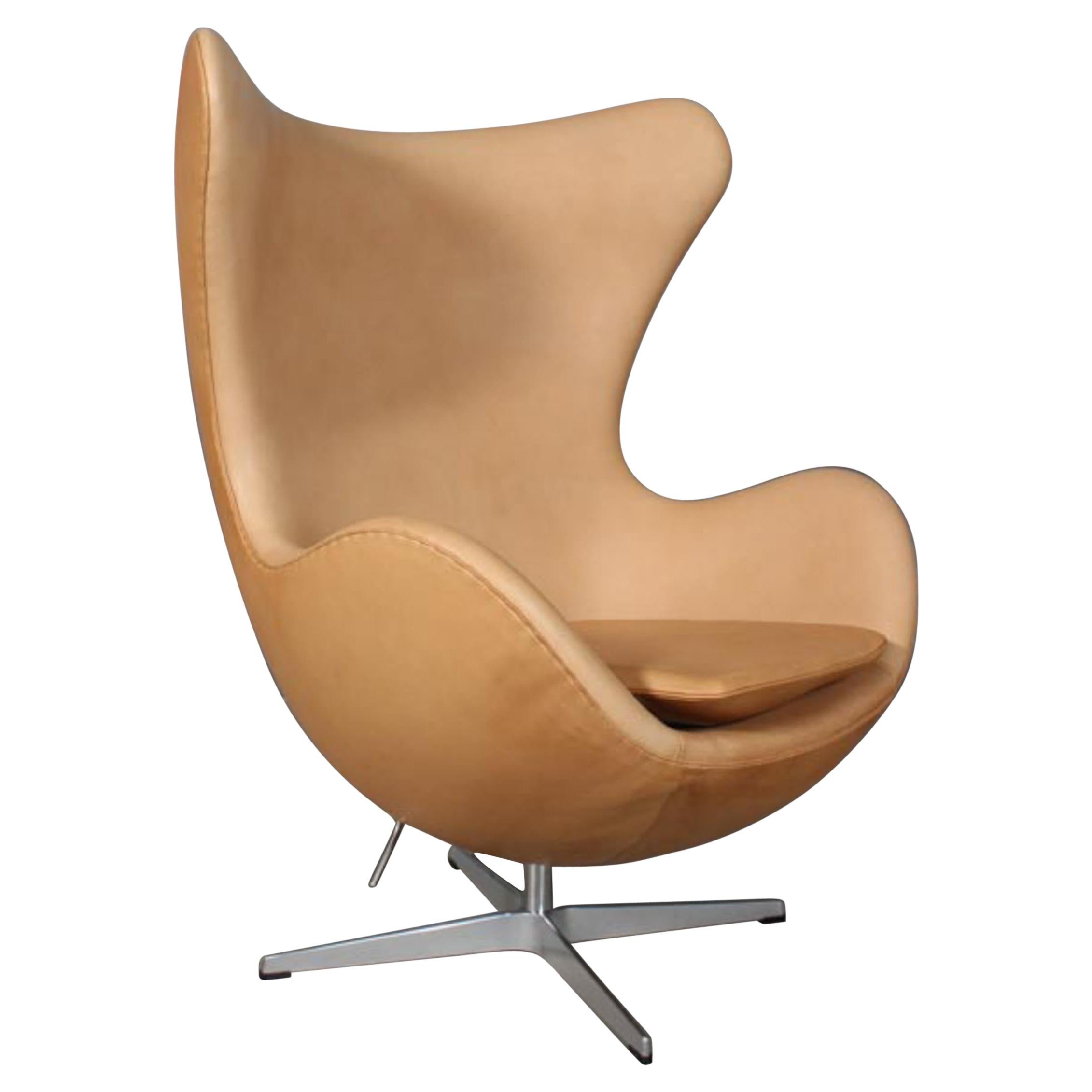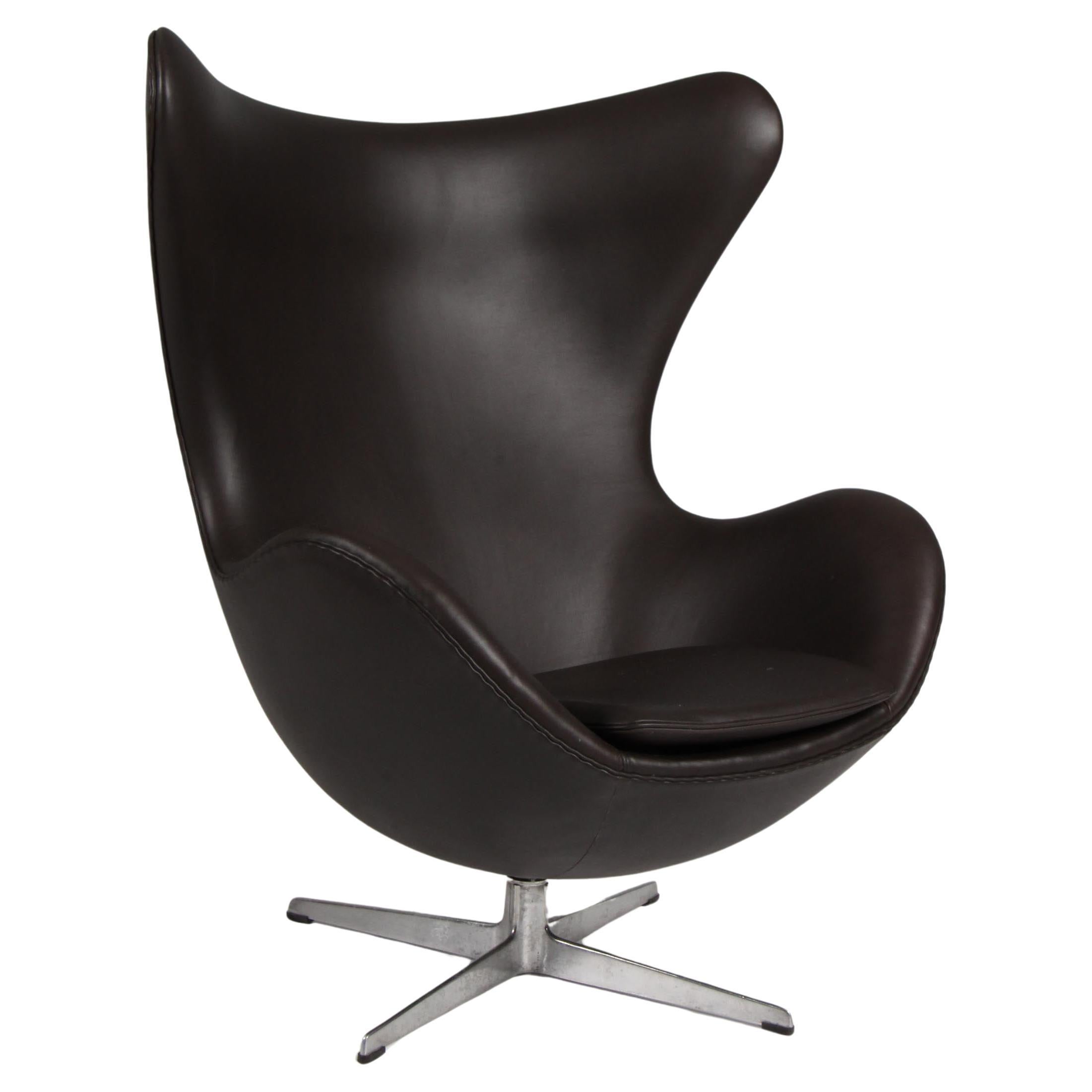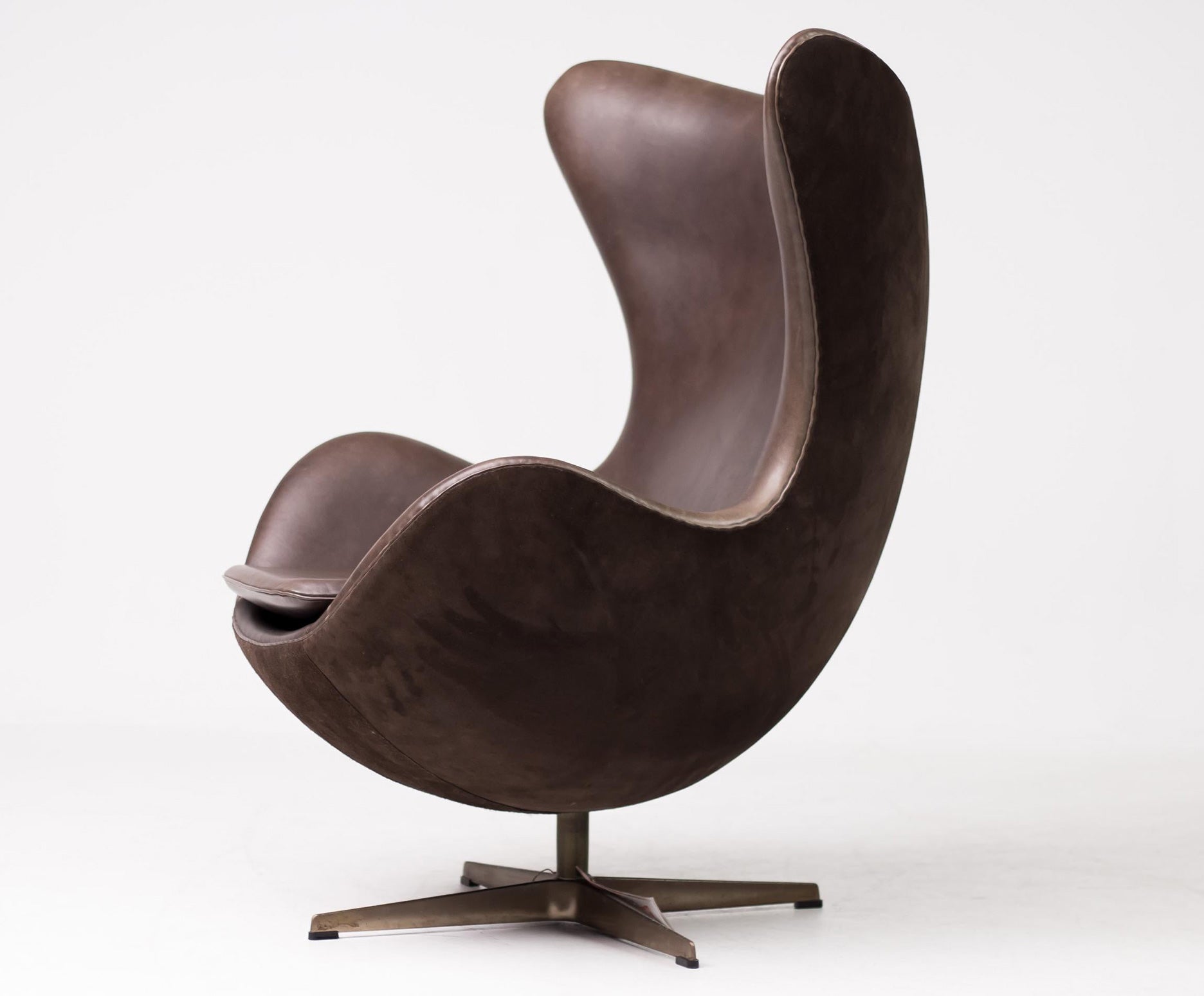Rare and old Edition Arne Jacobsen Egg Chair / Recliner Chair
About the Item
- Creator:Arne Jacobsen (Designer)
- Design:
- Dimensions:Height: 0.4 in (1 cm)Width: 0.4 in (1 cm)Depth: 0.4 in (1 cm)Seat Height: 0.4 in (1 cm)
- Style:Scandinavian Modern (Of the Period)
- Materials and Techniques:
- Place of Origin:
- Period:
- Date of Manufacture:1970
- Condition:Wear consistent with age and use. very good condition. No damages. Ready to use.
- Seller Location:Handewitt, DE
- Reference Number:1stDibs: LU8368234927742
Egg Chair
Designed in 1958 for the SAS Royal Hotel in Copenhagen, the Egg chair is a Scandinavian classic that has over the years become a fixture of corporate offices. It bears every mark of Arne Jacobsen's outsized perfectionism, for which the Danish architect was widely known.
The Egg chair was notable for its overtly organic appearance, which Jacobsen (1902–71) achieved with craft-based padding and upholstery finishing. Unlike the furniture maker’s previous range of shell chairs designed in laminated wood for Fritz Hansen, the Egg — and the Swan chair along with it — reflected a soulful new vision of modernity. Both created for the accommodation property, which opened in 1960, the chairs were meant to contrast with the SAS Royal Hotel’s straight lines as well as showcase Jacobsen’s eye for interiors.
A graduate from the Royal Danish Academy of Fine Arts, Jacobsen was a polymath who made just about everything — light fixtures, ashtrays, silverware and even door handles. For the SAS Air Terminal and Royal Hotel, he handled every detail, from textiles to furnishings. In the 1940s, the one-time mason found considerable success as an industrial designer, most notably with the Ant chair and Series 7 chairs for Fritz Hansen.
Jacobsen was influenced by modernism and designers like Ludwig Mies van der Rohe. Forward-looking projects like the “House of the Future” — codesigned with Flemming Lassen in 1929 and featuring a then-revolutionary automatic garage door opener — cemented his status as an innovator. Throughout his career, Jacobsen earned many awards, including the prestigious RIBA Bronze Medal in 1963.
With the Egg chair, Jacobsen continued his ongoing experimentation with synthetic materials. First, he devised small-scale clay models in his garage. The prototypes' finished shells were made of fiberglass-reinforced polyurethane foam, padded with cast latex foam rubber and then, upholstered with leather — or, in the cost-conscious hotel’s case, fabric.
Today, the Egg chair is supported by welded steel tubing and is mounted on a lightweight aluminum base. It is available from Fritz Hansen.
Arne Jacobsen
The eye-catching work of the Danish architect and designer Arne Jacobsen often introduces new collectors to mid-20th century furniture. With their fluid lines and sculptural presence, Jacobsen’s signature pieces — the elegant Swan chair and the cozy-yet-cutting edge Egg chair, both first presented in 1958 — are iconic representations of both the striking aesthetic of the designers of the era and their concomitant attention to practicality and comfort. Jacobsen designed furniture that had both gravitas and groove.
Though Jacobsen is a paragon of Danish modernism, his approach to design was the least “Danish” of those who are counted as his peers. The designs of Hans Wegner, Finn Juhl, Børge Mogensen and others grew out of their studies as cabinetmakers. They prized skilled craftsmanship and their primary material was carved, turned and joined wood. Jacobsen was first and foremost an architect, and while he shared his colleagues’ devotion to quality of construction, he was far more open to other materials such as metal and fiberglass.
Many of Jacobsen’s best-known pieces had their origin in architectural commissions. His molded-plywood, three-legged Ant chair (1952) was first designed for the cafeteria of a pharmaceutical company headquarters. The tall-backed Oxford chair was made for the use of dons at St. Catherine’s College, Oxford, whose Jacobsen-designed campus opened in 1962 (while still under construction). The Swan, Egg and Drop chairs and the AJ desk lamp were all created as part of Jacobsen’s plan for the SAS Royal Copenhagen Hotel, which opened in 1960. (The hotel has since been redecorated, but one guest room has been preserved with all-Jacobsen accoutrements.)
To Jacobsen’s mind, the chief merit of any design was practicality. He designed the first stainless-steel cutlery set made by the Danish silver company Georg Jensen; Jacobsen’s best-selling chair — the plywood Series 7 — was created to provide lightweight, stackable seating for modern eat-in kitchens. But as you will see from the objects on 1stDibs, style never took a backseat to function in Arne Jacobsen’s work. His work merits a place in any modern design collection.
Find authentic Arne Jacobsen chairs, tables, sofas and other furniture on 1stDibs.
- ShippingRetrieving quote...Ships From: Handewitt, Germany
- Return PolicyA return for this item may be initiated within 14 days of delivery.
- Swan Chairs by Arne Jacobsen for Fritz Hansen 1963 / New Upholstery with Arne SøBy Arne Jacobsen, Fritz HansenLocated in Handewitt, DEPair of old Arne Jacobsen „The Swan“, manufactured by Fritz Hansen, 1960s. New upholstery in Denmark with fine black „Canyon“ leather from Arne ...Category
Mid-20th Century Danish Scandinavian Modern Lounge Chairs
MaterialsAluminum
- Rare Pair of AV-53 Easychairs by Arne Vodder 1953By Arne VodderLocated in Handewitt, DEPair of model AV-53 by Arne Vodder for Ivan Schlechter Copenhagen. Designed in 1953. With legs in beautiful wood. Produced 1950s. All in original condition, with the Ivan Schlechter ...Category
Mid-20th Century Danish Scandinavian Modern Lounge Chairs
MaterialsFabric, Wood
- Pair of Old Spanish Chairs by Børge Mogensen early 1960sBy Børge MogensenLocated in Handewitt, DEBeautiful old pair of Børge Mogensen’s spanish chair. Designed 1958 for Fredericia Stolefabrik Denmark. Model BM2226. Old edition. Made in solid oak and natural leather. Produced ear...Category
Mid-20th Century Danish Scandinavian Modern Lounge Chairs
MaterialsLeather, Oak
- Fried Egg Teak Easychair by Hans Olsen 1950sBy Hans OlsenLocated in Handewitt, DEOld FRied Egg easychai by Hans Olsen for Bramin Denmark 1956. Produced 1950s in solid teak. Old versiion with screws. Later reupholstered in a red wool fabric from Kvadrat. This work...Category
Mid-20th Century Danish Scandinavian Modern Lounge Chairs
MaterialsFabric, Teak
- 1950sPrototype Lounge Chair by Danish Designer and Furniture Maker Svend SkipperBy Svend SkipperLocated in Handewitt, DEUnique easychair by the Danish designer and furniture maker Svend Skipper. This prototype has never gone into series and comes from the Private House of the Designer. Designed and ma...Category
Mid-20th Century Danish Scandinavian Modern Lounge Chairs
MaterialsBrocade, Teak
- BO-360 lounge chair and Footstool by Erik Ole Jørgensen for Bovirke 1953By Erik Ole JørgensenLocated in Handewitt, DERare offered lounge chair and footstool, model BO-360 by Erik Ole Jørgensen for Bovirke Denmark 1953. In cognac colored natural suede leather and green cushions. Base in chromed meta...Category
Mid-20th Century Danish Scandinavian Modern Lounge Chairs
MaterialsMetal
- Arne Jacobsen Egg ChairBy Arne Jacobsen, Fritz HansenLocated in Esbjerg, DKArne Jacobsen lounge chair model Egg. New upholstered with butter walnut aniline leather. Four star base. Made by Fritz Hansen. This iconic chair is one of the most famous chairs in the world and is recognized by design lovers in all countries. It is the classical midcentury Scandinavian designer...Category
Vintage 1960s Danish Scandinavian Modern Lounge Chairs
MaterialsLeather
- Arne Jacobsen Egg ChairBy Arne Jacobsen, Fritz HansenLocated in Esbjerg, DKNew Arne Jacobsen set of lounge chairs model Egg. New upholstered with Dakar black aniline leather. Four star base with tilt function. Made by Fritz Hansen. This iconic chair is one of the most famous chairs in the world and is recognized by design lovers in all countries. It is the classical midcentury Scandinavian designer...Category
2010s Danish Scandinavian Modern Lounge Chairs
MaterialsLeather
- Arne Jacobsen Egg ChairBy Arne Jacobsen, Fritz HansenLocated in Esbjerg, DKNew Arne Jacobsen set of lounge chairs model Egg. New upholstered with walnut aniline leather. Four star base with tilt function. Made by Fritz Hansen. This iconic chair is one of the most famous chairs in the world and is recognized by design lovers in all countries. It is the classical midcentury Scandinavian designer...Category
2010s Danish Scandinavian Modern Lounge Chairs
MaterialsLeather
- Arne Jacobsen Egg ChairBy Fritz Hansen, Arne JacobsenLocated in Esbjerg, DKArne Jacobsen set of lounge chairs model Egg. New upholstered with Dakar black aniline leather. Four star base with tilt function. Made by Fritz Hansen. This iconic chair is one of the most famous chairs in the world and is recognized by design lovers in all countries. It is the classical midcentury Scandinavian designer...Category
Vintage 1960s Danish Scandinavian Modern Lounge Chairs
MaterialsLeather
- Arne Jacobsen Egg ChairBy Fritz Hansen, Arne JacobsenLocated in Esbjerg, DKArne Jacobsen set of lounge chairs model Egg. New upholstered with Vacona Sahara aniline leather. Four star base with tilt function. Made by Fritz Hansen. This iconic chair is one of the most famous chairs in the world and is recognized by design lovers in all countries. It is the classical midcentury Scandinavian designer...Category
Vintage 1960s Danish Scandinavian Modern Lounge Chairs
MaterialsLeather
- Arne Jacobsen Egg ChairBy Arne Jacobsen, Fritz HansenLocated in Esbjerg, DKArne Jacobsen lounge chair model Egg. New upholstered with mokka butter aniline leather. Four star base profilated base. Made by Fritz Hansen. This iconic chair is one of the most...Category
Vintage 1960s Danish Scandinavian Modern Lounge Chairs
MaterialsLeather
Recently Viewed
View AllRead More
The 21 Most Popular Mid-Century Modern Chairs
You know the designs, now get the stories about how they came to be.
Arne Jacobsen’s Egg Chair Scrambled the Idea of What a Wingback Could Be
The curvaceous Egg was designed to cradle the body and offer privacy. Later, it became the seat of choice for bosses in movies, too.
